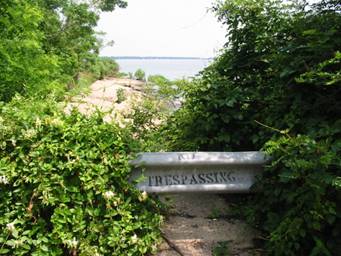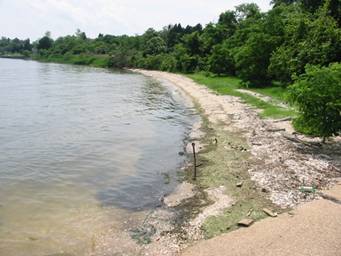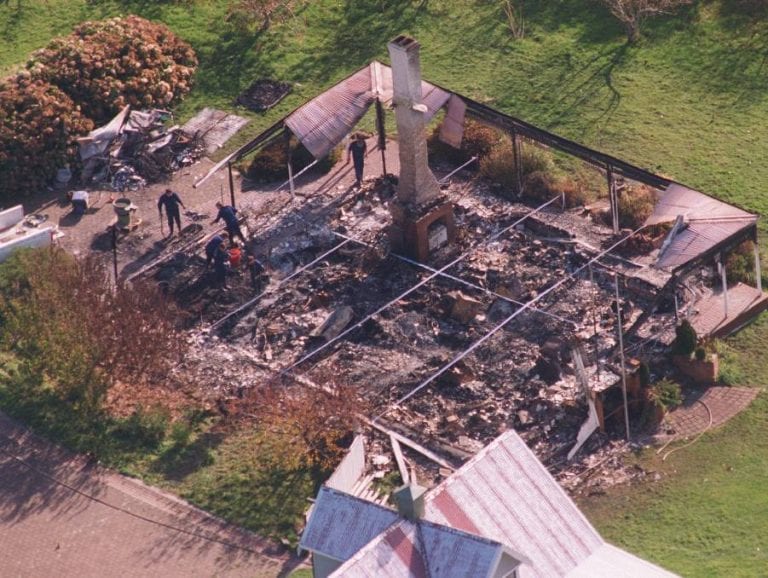Monday April 29 1996
A massive search effort began on Monday morning and went on day and night for the next few days. Over a dozen navy divers, aided by two helicopters, and volunteers in boats scoured the area. They used drag-lines to troll the two routes Colby took when he went canoeing. All together, there were around a hundred searchers.
I talked to Lt Mark Sanders of the Maryland Natural Resources Police. He was chief of the search effort. Drowning accidents were common around Cobb Island. The searchers were practiced and knew what they were doing. Yet even working 24 hours a day, they couldn’t find his body.
Something else they didn’t find: Colby’s life jacket.
When Colby went canoeing, he took the life jacket from the shed and put it in the boat. He didn’t wear it, but the life jacket was always with him. When he returned, he put it back in the shed. The life jacket had distinctive markings that made it easy to identify.
The search team found more than a dozen life jackets when they scoured the area. But not Colby’s. People who preferred to believe Colby had drowned—even his son Paul—remarked to me on this puzzlement. It was missing from the shed.
Colby’s body was found nine days later, on a Monday morning, about 40 meters from where Kevin Akers found the canoe. Both places were easily accessible by car and foot from a branch of Rock Point Road, which reached a dead-end at that point. Colby’s body was found by an assistant to LT Mark Sanders, on the edge of the shore, looking like he’d just been tossed in.
Divers had searched that area numerous times.
Timeline
I was trying to develop a timeline to explain Colby’s last day. This, I discovered, no one else had tried to do, not the police, not his family.
He had stopped by a well-known fish restaurant on Cobb Island, Captain John’s, to buy a dozen clams after he left the marina about 5:30 or 6 p.m. He called his wife 7 p.m. And sometime after 7:15 p.m. he had prepared his meal of clams and corn on the cob.
Carroll Wise estimated he would have finished up in the yard around 8 p.m. Maybe he finished a little earlier, maybe a little later, but I decided to call my wife Claude, who was considered a formidable cook, to give me her analysis.
Claude had met Colby in Saigon in 1970. She was a French medical journalist who had been captured and held for a week by the Khmer Rouge in Cambodia. I met her in connection with my investigation of the missing photographers Flynn and Stone.
Claude and I were having a drink one evening on the Continental Terrace when Colby saw us in passing and joined us. Colby had studied in France when he was young, and he and Claude hit it off immediately. She was very interested in my research on his case.
“Claude,” I said. “The sun sets at 7:57 p.m. Colby enters his house about that time and presumably begins to prepare dinner. How long does it take him?”
“Oh, Colby is seventy-six,” Claude said. “He’s not going to be moving around very fast. He’s going to steam the clams, boil the corn, open a bottle of wine. You say he laid down a place mat in the sunroom facing the water?
“Yes.”
“That means he is not in a hurry,” Claude said. “Otherwise he would eat at the kitchen table. So we’re talking about 20 to 30 minutes.”
The timeline was looking like something close to 8:30 p.m. when Colby supposedly jumped up from his unfinished meal and left to go canoeing. At 8:30 it was completely dark.
This drowning incident didn’t ring true. I wanted to talk to Kevin Akers but I couldn’t find him.
The Elusive Fisherman
All the interviews I did for this story took place in May and June 1996, except for one. I kept going back to Cobb Island in the following years and had lunch at Captain John’s, which made the trip worthwhile. But I never managed to find Kevin Akers. I finally connected with him seven years later, on June 14, 2003. So this interview is out of sequence.
Akers had taken a job at the Portside Marina, where Colby had kept his sailboat. Bare-chested and in jeans, he was arranging crab traps when I walked up to him. I told him I’d like to talk about the guy who died, the guy who owned the canoe he brought in.
“You mean somebody died?” he said, warily.
“Yeah, Colby, the ex-CIA director. I talked to everybody connected to the case, including his wife. But I couldn’t find you.”
“I didn’t want to be found,” he said. “The media was hounding me.”
When he realized that I had done the research, he started to loosen up and talked freely. He was glad to finally tell someone. He thought the danger to him had passed.
Akers jumped into his white pickup and led me to the end of Rock Point Road, about a mile away. We parked and stepped over the “No Trespassing” barrier, then found the path that led to the spot where he found the canoe.


“Okay, here’s where I found the canoe,” Akers said, pointing. “To the right, around that green spit of land behind me, maybe thirty or forty meters away, is where they found Colby’s body nine days later. It doesn’t make sense.”
“Why?”
“First, if he had really gone down near here, he would have washed up the next day or maybe two days later. But not nine days.”
“Yes, that didn’t make any sense to me, either,” I said. “Especially considering all the divers and people who were looking for him.”
“Second,” he said, “the canoe would have washed up at the same place they found the body, not here.”
“I don’t understand,” I said.
“Okay, look at the tip of that green spit,” he said. “That’s where the current suddenly shifts and turns in a clockwise motion. All of us who live out here know these currents very well. My house is just down the road and I’m out on the water all the time. That clockwise current would have pushed the canoe back to the right, where they found the body. I don’t think the canoe could have made it around the spit to wash up where we are standing.”
The clockwise current was clearly visible, yes, I could see it. It almost looked like a little whirlpool. I felt a little prickly on the back of my neck. This was a murder, not an accident.
Kevin Akers believed somebody had killed Colby and brought his body back a week later, on a Sunday night after weekenders had left, and dumped it when nobody was looking. Colby was discovered the next day, Monday, not far from Akers’ house.
I agreed with him that was probably what had happened. But I didn’t tell him why I believed that. In 1996 I was the only journalist to see Colby’s autopsy photos. And Colby appeared exactly as Akers was telling me seven years later. He looked like he had been in the water for one or two days—but certainly not for nine days.
The Maryland State Medical Examiner
John Smialek, Maryland’s chief medical examiner, was a smooth operator. He was 53-years-old, six-foot-one, gray, handsome, and wore loafers without socks. He spoke very carefully, sometimes hesitating in the middle of a sentence, thinking it out.
Smialek could tell I’d talked to medical examiners before. And he doubtless perceived what I was thinking: Medical examiners often knew only one thing for certain–that the decedent was dead. Everything else, except for the standard toxicology tests, was informed guesswork.
I’d seen dozens of drowned bodies floating in rivers in Indochina. A body sinks, then starts to decompose, and gases form that floats it to the surface, bloated and wasted. It is not a pretty sight.
I’d also been in touch with a forensic expert before I set up the appointment with Smialek. He told me that it was hard to determine a heart attack if a body had been in the water a long time. Decomposition dissolved blood clots. Actually, he said, it was hard to tell if someone died by drowning if the lungs were decomposed.
The Maryland state medical examiner’s office had, in effect, shut down the media circus that surrounded Colby’s disappearance. Scores of journalists had staked out his home with satellite trucks, the whole works, for the first week after he disappeared.
But after the medical examiner’s office put out the word that he had died of a heart attack the story was stopped in its tracks. If that was all it was, old guy kicks off with a bad ticker, then ho-hum, the media wasn’t interested. The journalists packed up and left Cobb Island and nobody followed up on the case until I came along.
Smialek and I exchanged the usual warm-up pleasantries. Then I turned on my tape recorder. It was June 5, 1996, at his office in Baltimore.
Did they have hard proof Colby drowned after having a heart attack? I asked.
“Cause of death is often a judgment call by the M.D. who performs the autopsy,” he said.
Smialek did not do the autopsy. That was performed by David R. Fowler, assistant medical examiner. But Smialek was closely in touch with what took place, since Colby was a high-profile case. Smialek had done autopsies on hundreds of drowning victims. He was the expert.
Colby had no history of heart problems and his wife said he was in very good shape. In fact, Smialek didn’t describe to me what had happened to Colby as a heart attack or stroke. He said it was probably a cardiovascular incident that deprived Colby of oxygen to the brain long enough to topple him out of the canoe.
“Can I see the autopsy report?”
“It’s not ready yet,” he said.
“Not ready?” I said, surprised. “The Colby case is pretty famous. You did the autopsy on May 6, 1996, exactly a month ago. And you haven’t got around to finishing the report?”
“We’ll fax it to you tomorrow,” he said.
I asked to see the autopsy photos.
Johnny D—that’s what he went by—Smialek’s assistant, returned with the photos and tossed them on the table. Johnny D was a blond guy with a mustache, in his early fifties. He had served in Vietnam, and liked to joke around. He struck me as Smialek’s fixer.
Colby was nude in the photos, which were taken from all angles. He was five-eight, 181 pounds, blue eyes.
“Hey, something doesn’t seem right,” I said. “I’ve seen a lot of drowning victims. But Colby hardly looks dead. He’s not bloated a bit.”
“Yes, Mr. Colby’s body looked very well preserved, even though it was clear that the body was decomposed and discolored,” Smialek said into my tape recorder. “He looked remarkably well.”
“What do you think that means?” I asked.
“I interpret that to mean the water was of a sufficiently low temperature that prevented the body from developing the type of gas decomposition that we commonly see with drowning victims when they’ve been in the water for an extended period.”
The water may have been cold but it wasn’t freezing, we’re talking about early May.
“How about the time of death?” I asked. Determining the time of a victim’s death based on his stomach contents was Forensics 101. Time of death was easy to estimate within a couple of hours, and medical examiners did it all the time.
“Based on the contents of his stomach he died one to two hours after eating,” Smialek said. “The contents included corn and clams.”
It was at this point that Smialek realized what I was doing. I had asked him if they could prove Colby died of a heart attack or stroke. He said no. He even said they couldn’t prove he had drowned.
I told him Colby looked to me in the photos like he was hardly dead and I wondered why. He agreed with me and said he thought it was because the water was cold. He added that Colby “looked remarkably well” based on the hundreds of drowned victims he’d seen.
Then I asked him how long they estimated he had lived after eating. He said one to two hours. And I think that rang his bell. He realized that I believed Colby had been murdered, and he had just given me important information for my timeline.
Let’s say that Carroll Wise, the gardener, was wrong, and it didn’t take Colby until 8 p.m. to finish watering his trees. Let’s say he finished 15 minutes after he saw Wise and went into his house to prepare his meal at 7:30 p.m.
It still would have taken him 20 to 30 minutes to prepare the corn and clams and sit down to eat part of it. Let’s say he suddenly decided to go boating and hurried out of his house at 8 p.m. Smialek said he had died between one and two hours after eating.
That meant he would have died between 9 p.m. and 10 p.m. paddling around on the water in the pitch-black darkness.
Who could believe that?
The Autopsy Report
John Smialek faxed me the autopsy report the next day. It was five pages long and dated June 6, 1996. There were two possibilities, I thought. Either the report was written the day after our interview. Or it was already written and then changed after our interview. Because the report was in conflict with several important things Smialek had told me in our tape-recorded interview in front of two witnesses.
The autopsy report said Colby appeared in surprisingly good shape for a man of his age. But the gist of the report came down to the last paragraph. The paragraph was titled: “Opinion.”
“This 76-year-old white male, William E. Colby, died of drowning and hypothermia associated with arteriosclerotic cardiovascular disease. He was found floating in an advanced state of decomposition nine days after being reported missing. Identity was confirmed by dental examination. He had severe calcified atherosclerosis which would predispose him to a stroke or heart attack. Decomposition, however, will lyse (dissolve) clots and the fatty material in atheroma. It is likely he suffered a complication of this atherosclerosis which precipitated him into the cold water in a debilitated state and he succumbed to the effects of hypothermia and drowned. The contents of his stomach are consistent with his last reported meal and indicate his death was shortly after his dinner. The manner of death is ACCIDENT. The deceased had been consuming alcoholic beverages prior to death.”
First: “died of drowning and hypothermia.” Smialek told me they couldn’t be sure he had drowned. There was a little water in the lung area but his lungs were too decomposed to make a definitive determination, he said.
Second: “found floating in a state of advanced decomposition.” Maybe he was in a state of advanced internal decomposition, likely for anyone who had been dead for nine days. But he certainly wasn’t in a state of advanced external decomposition. Smialek had agreed with me, and so had Johnny D, that Colby looked in remarkably good condition.
Third: “Identity was confirmed by dental examination.” That makes it sound like he was in such bad shape that dental records were needed to establish who he was.
In fact, Sally Shelton had absolutely no problem identifying Colby. But the medical examiner’s office demanded dental records as a matter of required procedure. She phoned CIA four times and asked for his dental records. They ignored her calls. When the CIA director phoned to offer his condolences, he asked if there was anything he could do for her.
“Yes, get your guys to answer my calls,” she said. She was still steamed about this when I talked to her. Both the CIA and FBI ignored Colby’s death and let a county sheriff’s office run the investigation.
Fourth: “The contents of his stomach are consistent with his last reported meal and indicate his death was shortly after his dinner.”
Shortly after his dinner? Smialek told me that he had examined hundreds of drowning victims and the contents of Colby’s stomach indicated he had died between one and two hours after eating.
It looked to me like the medical examiner’s office wanted this be seen as an accident so no one could claim that the Maryland police or anyone associated with the state had screwed up the investigation.
I wondered if their final sentence about Colby “consuming alcoholic beverages” was supposed to suggest Colby had been drunk. Why didn’t they just state his actual alcohol level (O.07), which bordered on but was not high enough to get Colby a DUI in Maryland or anywhere in the U.S.
After our interview ended Johnny D showed me around their offices. I knew that the examiner who did the autopsy had told Sally Shelton that Colby was dead when he hit the water.
I said, “That doesn’t square with what John Smialek just told me.
Johnny D said, “We always try to make it as easy as possible for the victim’s families.”
What he meant was that Sally Shelton, like any wife, would prefer to hear that her husband had died instantly and without pain, rather than to be told, “We really can’t say for sure how he died, this is just our opinion.”
But if Smialek and his guys wanted to fudge a bit to make Colby’s death look like an indisputable drowning accident that was okay by me. I had a chance for another piece of evidence that might establish beyond a reasonable doubt that he was murdered.
It was Colby’s telephone bill for April 27, 1996.
Continued on next page…



